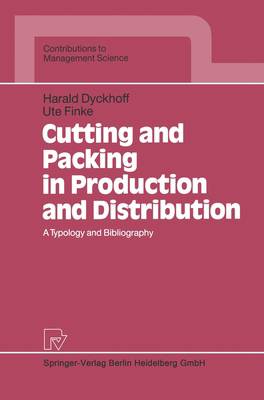
- Retrait en 2 heures
- Assortiment impressionnant
- Paiement sécurisé
- Toujours un magasin près de chez vous
- Retrait gratuit dans votre magasin Club
- 7.000.0000 titres dans notre catalogue
- Payer en toute sécurité
- Toujours un magasin près de chez vous
Cutting and Packing in Production and Distribution
A Typology and Bibliography
Harald Dyckhoff, Ute Finke, H Dyckhoff
151,45 €
+ 302 points
Format
Description
1 Introduction.- 1.1. Purpose of the Investigation.- 1.2. Methodology Used.- 1.3. Structure of the Book.- 2 Cutting and Packing Problems as Geometric-Combinatoric Problems.- 2.1. Basic Logical Structure.- 2.2. Phenomena of Cutting and Packing.- 2.2.1. Cutting and Packing in Spatial Dimensions.- 2.2.2. Cutting and Packing in Abstract Dimensions.- 2.2.3. Related Problems.- 2.3. Delimitation in Investigation.- 3 The Treatment of Cutting and Packing Problems in the Literature.- 3.1. Models as Idealized Images of Actual Phenomena.- 3.2. Sources on Cutting and Packing Problems.- 3.2.1. Differentiation According to Thematic Criteria.- 3.2.2. Differentiation According to Bibliographical Criteria.- 3.3. Delimitation of Investigated Literature.- 4 Systematic Catalogue of Properties for the Characterization of Cutting and Packing Problems.- 4.1. Basis for Characteristic Properties.- 4.2. Design of the Catalogue.- 4.3. Characteristics Based on the Logical Structure.- 4.3.1. Dimensionality.- 4.3.2. Type of Assignment.- 4.3.3. Characteristics of Large Objects and Small Items.- 4.3.4. Pattern Restrictions.- 4.3.5. Objectives.- 4.3.6. Status of Information and Variability of Data.- 4.3.7. Solution Methods.- 4.4. Reality-Based Characteristics.- 4.4.1. Kind of Objects and Items, and Branch of Industry.- 4.4.2. Planning Context.- 4.4.3. Software.- 4.5. Overview.- 5 Types of Cutting and Packing Problems in the Literature.- 5.1. Principles of Type Definition.- 5.2. Hierarchical Catalogue of Types.- 5.2.1. General Types.- 5.2.2. Special Types.- 5.2.3. Summarized Description of the Hierarchy of Types.- 5.3. Properties of the Derived Problem Types.- 6 Bin Packing Types (BP).- 6.1. One-dimensional Bin Packing Type (BP1).- 6.2. Two-dimensional Bin Packing Types (BP2).- 6.2.1. BP2-Type with a Heterogeneous Assortment of Large Objects.- 6.2.2. BP2-Type with a Homogeneous Assortment of Large Objects.- 6.3. Actual Bin Packing Problems.- 7 Cutting Stock Types (CS).- 7.1. One-dimensional Cutting Stock Types (CS1).- 7.1.1. CS1-Type with Continuous Quantity Measurement of Large Objects.- 7.1.2. CS1-Types with Discrete Quantity Measurement of Large Objects.- 7.1.2.1. Discrete CSl-Type with a Homogeneous Assortment of Large Objects.- 7.1.2.2. Discrete CSl-Type with a Heterogeneous Assortment of Large Objects.- 7.2. Two-dimensional Cutting Stock Types (CS2).- 7.2.1. CS2-Type with Non-rectangular Small Items.- 7.2.2. CS2-Types with Rectangular Small Items.- 7.2.2.1. Rectangular CS2-Types with Only One Large Object per Figure.- 7.2.2.2. Rectangular CS2-Types with Guillotine Patterns.- 7.2.2.3. Rectangular CS2-Type with Nested Patterns.- 7.3. Three-dimensional Cutting Stock Type (CS3).- 7.4. Actual Cutting Stock Problems.- 8 Knapsack Types (KS).- 8.1. One-dimensional Knapsack Type (KS1).- 8.2. Two-dimensional Knapsack Type (KS2).- 8.3. Three-dimensional Knapsack Type (KS3).- 8.4. Actual Knapsack Problems.- 9 Pallet Loading Types (PL).- 9.1. Two-dimensional Pallet Loading Type (PL2).- 9.2. Three-dimensional Pallet Loading Type (PL3).- 9.3. Actual Pallet Loading Problems.- 10 Conclusions.- I. A Bibliography of Further C&P-Problems.- A. Published Surveys.- B. Literary References not Closely Analysed.- C. Most Recent Sources.- II. Brief Description of the Characteristics.- III. LARS Data Base System.- List of Abbreviations for the Journals.- I. General Literature.- II. C&P-Literature.
Spécifications
Parties prenantes
- Auteur(s) :
- Editeur:
Contenu
- Nombre de pages :
- 264
- Langue:
- Anglais
- Collection :
Caractéristiques
- EAN:
- 9783790806304
- Date de parution :
- 24-08-92
- Format:
- Livre relié
- Format numérique:
- Genaaid
- Dimensions :
- 170 mm x 244 mm
- Poids :
- 621 g

Seulement chez Librairie Club
+ 302 points sur votre carte client de Librairie Club
Les avis
Nous publions uniquement les avis qui respectent les conditions requises. Consultez nos conditions pour les avis.






